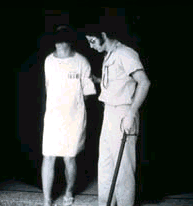 |
 |
 |
 |
After half a day of this treatment, the guards then took some of these "good" prisoners and put them into the "bad" cells, and took some of the "bad" prisoners and put them into the "good" cell, thoroughly confusing all the prisoners. Some of the prisoners who were the ringleaders now thought that the prisoners from the privileged cell must be informers, and suddenly, the prisoners became distrustful of each other. Our ex-convict consultants later informed us that a similar tactic is used by real guards in real prisons to break prisoner alliances. For example, racism is used to pit Blacks, Chicanos, and Anglos against each other. In fact, in a real prison the greatest threat to any prisoner's life comes from fellow prisoners. By dividing and conquering in this way, guards promote aggression among inmates, thereby deflecting it from themselves.
The prisoners' rebellion also played an important role in producing greater solidarity
among the guards. Now, suddenly, it was no longer just an experiment, no longer a simple simulation. Instead, the guards saw the prisoners as troublemakers who were out to get them, who might really cause them some harm. In response to this threat, the guards began stepping up their control, surveillance, and aggression.

|
 |



 |
|
 |
 |
 |







